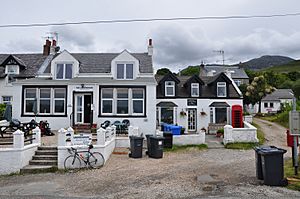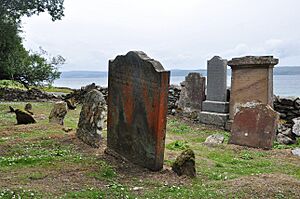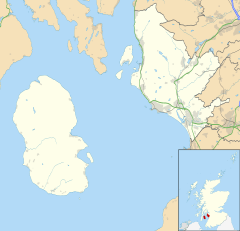Pirnmill facts for kids
Quick facts for kids Pirnmill
|
|
|---|---|
 Village store/post office and restaurant in the centre of Pirnmill |
|
| Population | 110 |
| OS grid reference | NR871442 |
| Civil parish |
|
| Council area | |
| Lieutenancy area |
|
| Country | Scotland |
| Sovereign state | United Kingdom |
| Post town | ISLE OF ARRAN |
| Postcode district | KA27 |
| Dialling code | 01770 |
| Police | Strathclyde |
| Fire | Strathclyde |
| Ambulance | Scottish |
| EU Parliament | Scotland |
| UK Parliament |
|
| Scottish Parliament |
|
Pirnmill (which is Muileann nam Piùirneachan in Gaelic) is a small village in Scotland. You can find it on the north-west coast of the beautiful island of Arran. It sits right on the Kilbrannan Sound, looking across the water towards Grogport on the Kintyre peninsula. Pirnmill is part of the Kilmory area. It's surrounded by smaller settlements called clachans, like Whitefarland to the south and Thunderguy to the north. The original village, called Penrioch, was actually located just above Pirnmill.
Contents
Why is it Called Pirnmill?
Unlike many other villages on Arran, Pirnmill's name doesn't come from old Gaelic or Norse words. Instead, it gets its name from a special mill. This mill was called Salen Pirn Mill.
It was built around 1780 to make pirns. A pirn is a type of wooden bobbin. These bobbins were used in the cotton industry. The company J&P Clarks of Paisley built the mill. A large 40-foot water wheel powered it. This wheel turned using water from a dam. The fast-flowing Allt Gobhlatch river filled the dam.
The mill worked until 1840. After that, there wasn't enough wood on the island. It became too expensive to bring timber to the island. In 1850, the mill was destroyed by a fire.
A Look Back at Pirnmill's Past
In the early days, people in Pirnmill made a living by fishing for herring. They also did crofting, which is a type of small-scale farming. Later, Pirnmill became a popular place for tourists. Many large boats called Clyde steamers traveled between Glasgow and Campbeltown.
Small ferry boats would take visitors from the steamers to the shore. People had to move from the big steamer to the small ferry. They would then be rowed to land. Archibald Currie was one of the last local ferrymen. He even put a small engine on one of his boats!
During the Second World War, the steamers stopped running. They never really started up again. Today, most visitors come to Pirnmill by road. Some also arrive by private yacht.
The jetty you see below the shop was built in the 1930s. It made it much easier for visitors and cargo to get off the small ferries. Before that, there were only simple wooden walkways.
Old Church Buildings in Pirnmill
Pirnmill used to have two church buildings. The Church of Scotland met in a building south of the village. This church closed in the 1990s. There is still a memorial there for Rev John Kennedy of Lenimore. It is made of white granite and looks like an old Gothic building. It dates back to 1910.
A bit further north, there's another building from the 1920s. Members of the Free Church of Scotland built it. They used to worship at Lenimore. This building was first a church hall. But it was used for worship after the Lenimore building was taken down.
The Church of Scotland rented this building from the 1990s. They used it until January 29, 2023, when the church closed. It's a rectangular building made of corrugated iron. It has a concrete base and an asbestos roof. Inside, it's lined with yellow pine boards. This type of building was meant to be temporary. You could order them from a catalogue a long time ago. Not many of these temporary buildings are left today. This one hasn't changed much from when it was built.
How Pirnmill Gets Its Power
On the southern edge of the village, you'll find the turbine house. This is part of the Dougarie Hydro-Electric Scheme. A hydro-electric scheme uses water to make electricity. The Dougarie Estate started planning this project in 2008. They checked the water flow in four streams. In 2012, they got permission to build it.
The plan was to use water from the Allt Gobhlach river. The estate made sure to tell local people about their plans. They put a document in the Post Office. They also sent a copy to everyone living nearby. Most villagers liked the idea. The power station started working in June 2013. It makes 500 kilowatts of power. This power goes into the National Grid, which supplies electricity across the country.
What Pirnmill Offers Today

Pirnmill has a village shop where you can buy things. There's also a restaurant and a bed and breakfast (B&B) for visitors. Once a month, they even have a 'Pop Up Pub'! About 2 miles (3.2 km) north of the village, between Pirnmill and Catacol, there's an ancient burial ground. It's located close to the shore at Rhubha Airigh Bheirg.
Famous People from Pirnmill
- Flora Drummond - Flora was a very important woman. She was a suffragette. This means she fought for women to have the right to vote. Flora was born in Manchester in 1878. But her family moved to Pirnmill within a year of her birth. She grew up and went to school on Arran. When she was 14, she moved away to Glasgow.


